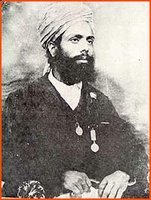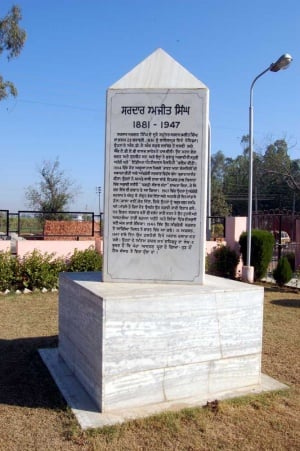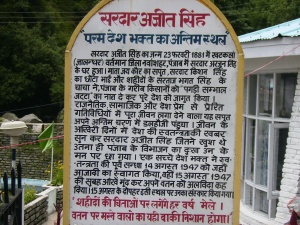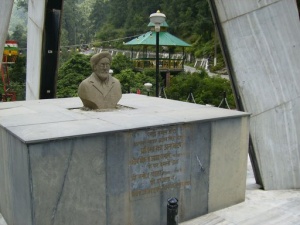Sardar Ajit Singh: Difference between revisions
Allenwalla (talk | contribs) m (link corrected mis statement that he spent whole life in jail as stated in wikiped article) |
Allenwalla (talk | contribs) mNo edit summary |
||
| Line 4: | Line 4: | ||
His elder brother was Sardar [[Kishen Singh]] Sinhu and his nephew was [[Shaheed Bhagat Singh|Sardar Bhagat Singh]]. | His elder brother was Sardar [[Kishen Singh]] Sinhu and his nephew was [[Shaheed Bhagat Singh|Sardar Bhagat Singh]]. | ||
He was born at Khatkarkalan village in Jalandhar District taking his early education at the village school. He matriculated from his | He was born at Khatkarkalan village in Jalandhar District taking his early education at the village school. He matriculated from his uncle's school at Jullundur then studied at D.A.V. College, Lahore and later on at Law College, Barreily. But, during his first year of law his chilhood dislike of the British ruling Punjab grew and he plunged into the freedom movement leaving his law studies. Attending the Darbar of Lord Kurzon in 1903 he sought to organize the Princes or Maharajas of the Princely states to unite against the British. Towards the aim of fully understanding the minds of his adversaries he started giving lessons in Urdu and Panjabi, many british officers became his students. In 1906 he attended the Congress session in Calkutta with the idea of feplacing the Congress and changing its path. After Calkutta he returned to the Punjab and formed along wih his elder brother, Sardar Kishen Singh and Ghasita Ram the Bharat Mata Society to arouse public feelings and launch a campaign of agitation against British rule in India in the Punjab. They sought to enlist the assistance of Lajpat Rai, but he considered the idea rash going so far as to call Ajit Singh a hothead. | ||
In 1907, after giving one too many speeches in which the crowds grew unruly and threatened British citizens and bussiness, it was the 50th anniversary of the Sepoi Mutinee and the British were growing very fearfull of their small numbers. After Lajput Rai was arreasted he learned that a warrent was out for his arrest, as well. Trying not to raise unrest any further he volunteered himself for arrest telling the British when and where he would be walking alone. He was deported to Mandalay Jail in Burma along with Lala Lajpat Rai. After his on November 11th he returned to the Punjab. In 1908 he left the Punjab traveling to Iran, which had developed as a centre for revolutionary activities by groups led by Sardar Ajit Singh and Sufi Amba Prasad who had worked there since 1909. The recruits to these groups included young nationalists of the likes of Rhishikesh Letha, Zia-ul-Haq and Thakur Das. By 1910, the activities of these groups and their publication, the Hayat, had been noticed by British intelligence. Reports as early as 1910 indicated German efforts to unite Turkey and Persia and proceed to Afghanistan to threaten British India. However, Ajit Singh's departure in 1911 brought the Indian revolutionary activities to a grinding halt, while British representations to Persia successfully curbed whatever activity that remained in the country. From there, he traveled to Rome, Geneva, Paris, and Rio de Janeiro. | In 1907, after giving one too many speeches in which the crowds grew unruly and threatened British citizens and bussiness, it was the 50th anniversary of the Sepoi Mutinee and the British were growing very fearfull of their small numbers. After Lajput Rai was arreasted he learned that a warrent was out for his arrest, as well. Trying not to raise unrest any further he volunteered himself for arrest telling the British when and where he would be walking alone. He was deported to Mandalay Jail in Burma along with Lala Lajpat Rai. After his on November 11th he returned to the Punjab. In 1908 he left the Punjab traveling to Iran, which had developed as a centre for revolutionary activities by groups led by Sardar Ajit Singh and Sufi Amba Prasad who had worked there since 1909. The recruits to these groups included young nationalists of the likes of Rhishikesh Letha, Zia-ul-Haq and Thakur Das. By 1910, the activities of these groups and their publication, the Hayat, had been noticed by British intelligence. Reports as early as 1910 indicated German efforts to unite Turkey and Persia and proceed to Afghanistan to threaten British India. However, Ajit Singh's departure in 1911 brought the Indian revolutionary activities to a grinding halt, while British representations to Persia successfully curbed whatever activity that remained in the country. From there, he traveled to Rome, Geneva, Paris, and Rio de Janeiro. | ||
Revision as of 14:22, 14 July 2008
Sardar Ajit Singh Sindhu was born in a military family from Punjab in India. His Grandfather was Sardar Fateh Singh Sinhu. Ajit Singh was one of the first men in the Punjab to openly resent the high-handedness of the British rule and to openly criticize the government. He was declared a political rebel deported to Mandalay for a while and spent much of his adult life as an Indian expatriot. He was in Naples when WWII broke out where he was asked to teach Persian at a University in Naples. He also gave a number of speeches in Hindustani, broadcasting to Indian soldiers serving in the British Army in North Africa. His speeches were aimed at raising an Azad Hind Fauj to fight against the British in India.
His elder brother was Sardar Kishen Singh Sinhu and his nephew was Sardar Bhagat Singh.
He was born at Khatkarkalan village in Jalandhar District taking his early education at the village school. He matriculated from his uncle's school at Jullundur then studied at D.A.V. College, Lahore and later on at Law College, Barreily. But, during his first year of law his chilhood dislike of the British ruling Punjab grew and he plunged into the freedom movement leaving his law studies. Attending the Darbar of Lord Kurzon in 1903 he sought to organize the Princes or Maharajas of the Princely states to unite against the British. Towards the aim of fully understanding the minds of his adversaries he started giving lessons in Urdu and Panjabi, many british officers became his students. In 1906 he attended the Congress session in Calkutta with the idea of feplacing the Congress and changing its path. After Calkutta he returned to the Punjab and formed along wih his elder brother, Sardar Kishen Singh and Ghasita Ram the Bharat Mata Society to arouse public feelings and launch a campaign of agitation against British rule in India in the Punjab. They sought to enlist the assistance of Lajpat Rai, but he considered the idea rash going so far as to call Ajit Singh a hothead.
In 1907, after giving one too many speeches in which the crowds grew unruly and threatened British citizens and bussiness, it was the 50th anniversary of the Sepoi Mutinee and the British were growing very fearfull of their small numbers. After Lajput Rai was arreasted he learned that a warrent was out for his arrest, as well. Trying not to raise unrest any further he volunteered himself for arrest telling the British when and where he would be walking alone. He was deported to Mandalay Jail in Burma along with Lala Lajpat Rai. After his on November 11th he returned to the Punjab. In 1908 he left the Punjab traveling to Iran, which had developed as a centre for revolutionary activities by groups led by Sardar Ajit Singh and Sufi Amba Prasad who had worked there since 1909. The recruits to these groups included young nationalists of the likes of Rhishikesh Letha, Zia-ul-Haq and Thakur Das. By 1910, the activities of these groups and their publication, the Hayat, had been noticed by British intelligence. Reports as early as 1910 indicated German efforts to unite Turkey and Persia and proceed to Afghanistan to threaten British India. However, Ajit Singh's departure in 1911 brought the Indian revolutionary activities to a grinding halt, while British representations to Persia successfully curbed whatever activity that remained in the country. From there, he traveled to Rome, Geneva, Paris, and Rio de Janeiro.
In 1918, he came in close contact with the Ghadar Party in San Francisco. In 1939, he returned to Europe and later on broadcastted rebellion to Indian troops in Africa and worked to raise troops from captured Indian soldiers emprisoned in Italy. He advised Netaji Subhas Chandra Bose to learn to speak Hindostani as he had only been able to enlist 25 members in the Berlin Azad Hind Fauj where he and his partners in Italy had raised more than 10,000.
At the end of the war he was imprisoned by the British who intended to see that he was punished for his work on behalf of the Axis powers. Turned over at one time to the care of an American camp he shared the facts of why he had worked against the British in the war and was promtly freed and sent on his way by an American officer who had considered him a patriot like those who had worked to win America's freedom from British rule. But the British were quick to arrest him again. After suffering from imprisonment in bad, often cold, damp conditions with little food or medical treatment (one time, he thought that he was purposely mis-diagnosed with tubeculosis and then forced to sleep between two very ill tuberculosis patients. Eventually released he finally made it to Britain and the good care of his well wishers and admirers.
In 1946, he came back to India at the invitation of Pandit Jawaharlal Nehru. After spending some time in Delhi, he came to Dalhousie. There in poor health, he Ironically, breathed his last breath, on the very day that India got its Independence--the cause for which he had laboured his whole adult life.
On August 15, 1947 His last words were, "Thank God, my mission is fulfilled."
A samadhi in his memory is at Panjpula, a popular and scenic picnic spot in Dalhousie. Perhaps less well known than Bose, and not featured in films like his famous nephew Sardar Bhagat Singh, he was never-the-less a leading figure in the cause of India's independance.
References
- 1. ^ Yadav 1992, p. 29
- 2. ^ a b c Yadav 1992, p. 30
- Yadav, B.D (1992), M.P.T. Acharya, Reminiscences of an Indian Revolutionary, Anmol Publications Pvt ltd, ISBN 8170414709.




